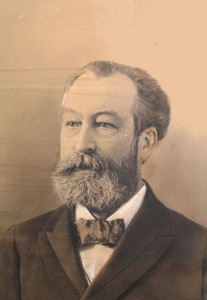
Beneath a hemlock grim and dark,
Where shrub and vine are intertwining,
Our shanty stands, well roofed with bark,
On which the cheerful blaze is shining.
The smoke ascends in spiral wreath,
With upward curve the sparks are trending;
The coffee kettle sings beneath
Where sparks and smoke with leaves are blending.
And on the stream a light canoe
Floats like a freshly fallen feather,
A fairy thing, that will not do
For broader seas and stormy weather.
Her sides no thicker than the shell Of Ole Bull’s Cremona fiddle,
The man who rides her will do well
To part his scalp-lock in the middle.
—”Forest Runes”—Nessmuk.


James Solomon Sanborn was born in Wales, Maine, in 1835 and lived on Sanborn Road, Monmouth, as a child. He founded J.S. Sanborn Co. in Lewiston before 1870, selling spices, tea and coffee, then moved to Boston, where Caleb Chase owned a coffee roasting business. The men partnered to form Chase & Sanborn Coffee and Tea Company in 1874.
They were the first to package ground coffee in sealed cans which became a major selling point for the company and helped grow their company into a nation wide household name. They grew to such a point that they established a Chicago branch in 1880, to be followed in 1882 by the opening of a house in Montreal Canada. In 1893 they supplied all the coffee for the Chicago World’s Fair!
Caleb Chase got experience in sales and as a food merchant, eventually he moved to Boston working in a dry goods store. It wasn’t long before Caleb Chase decided to create a business as a coffee roaster, taking on two partners. One of the partners was James Sanborn of Maine. By 1862, Chase & Sanborn Coffee would be established in the middle of the American Civil War. Their third partner, Charles Sias became the marketing master, helping the company grow from distribution to Chicago and Montreal to establish shipping to major cities in Canada and the Southern and the Western states. By 1880, the company had made $1 million a year in profits and did not go below that again. Their innovations and marketing skills were brilliant and helped create a long-lasting brand.
Caleb Chase was a tremendous Philanthropist and in the end he left his fortunes in different ways to his community, church and surprisingly even his large number of employees. This ideology permeated the Chase and Sanborn’s branding and advertising campaigns in a unique way of expanding knowledge. This is a testament example of the Gilded Age Philanthropist like Andrew Carnegie. The Chase and Sanborn company disseminated educational booklets, for country-wide distribution in homes, libraries, and schools. The History of the American Flag, North American Birds, Animal Booklets, Butterfly Booklets, Tea and Coffee Booklets, and the Story of the Pilgrim Fathers have been notable examples of a kind of advertising that was “productive of lasting goodwill, since it not only educated old and young alike in worth-while subjects but, in the case of the children, acquainted them in their most impressionable years with Chase & Sanborn merchandise.” (Gjenvick Gjonvik Archives)

https://www.ggarchives.com/Epicurean/CoffeeAndTea/GrowthOfChaseAndSanborn-1922.html



If you enjoy traditional campcrafting, bushcrafting, hiking, hunting, or other outdoor adventure then I invite you to join us in the Guild!